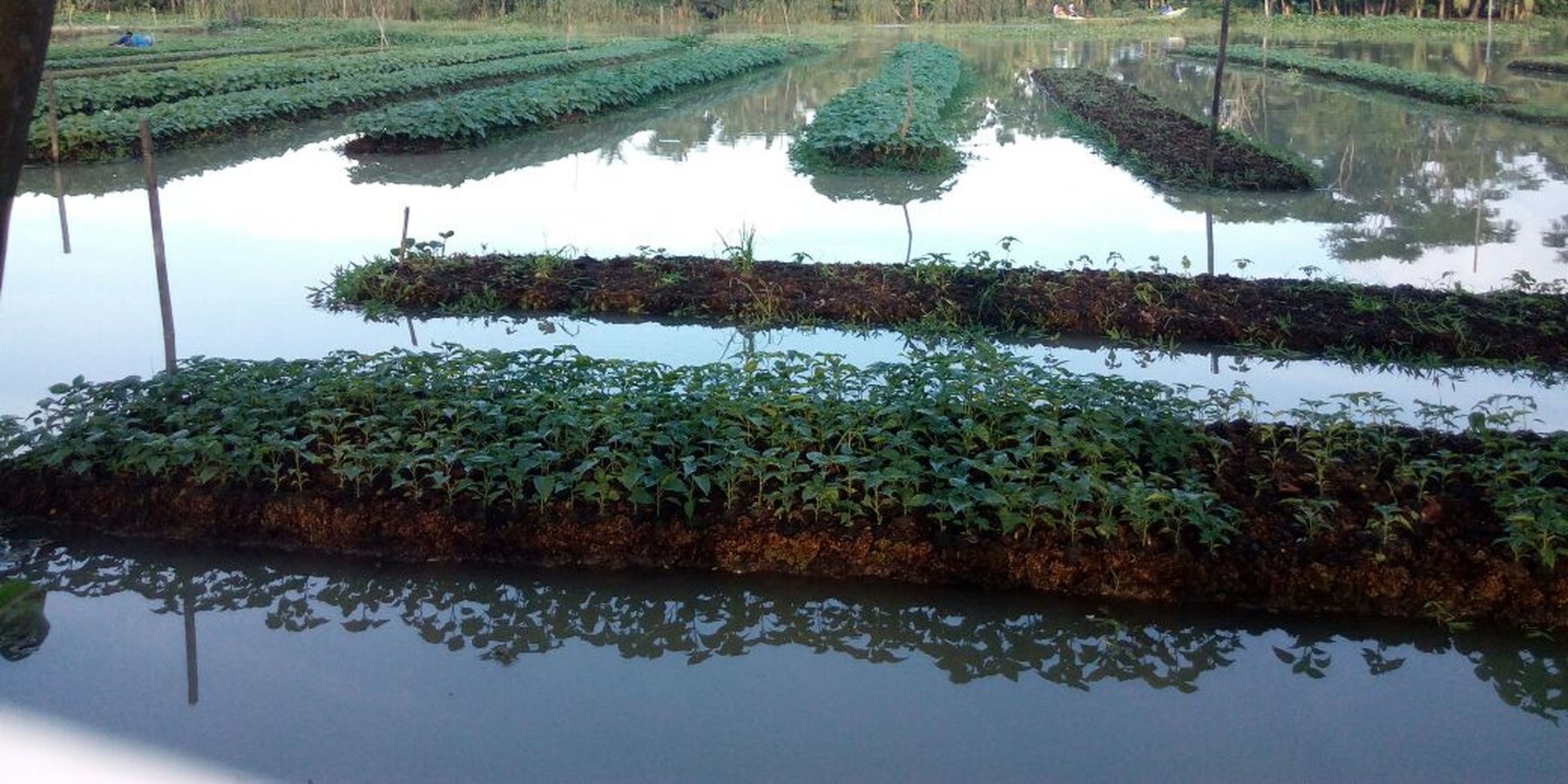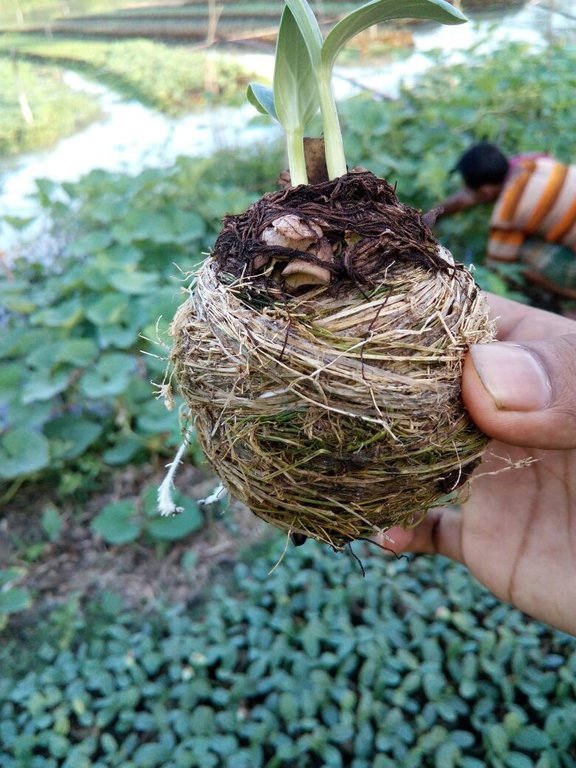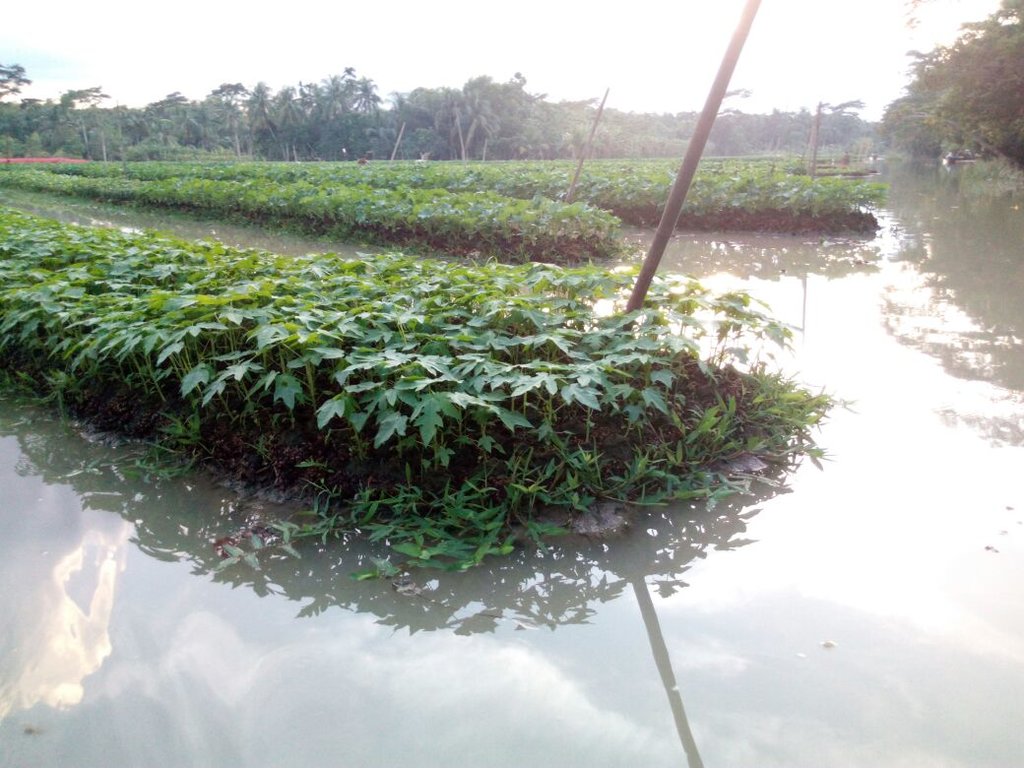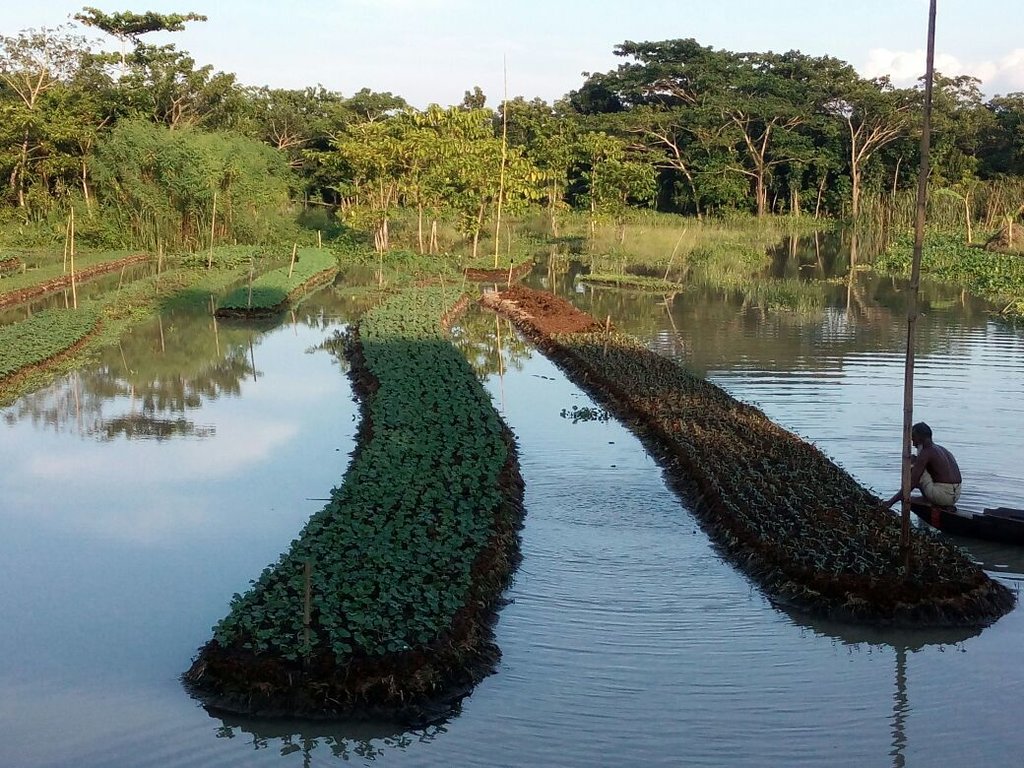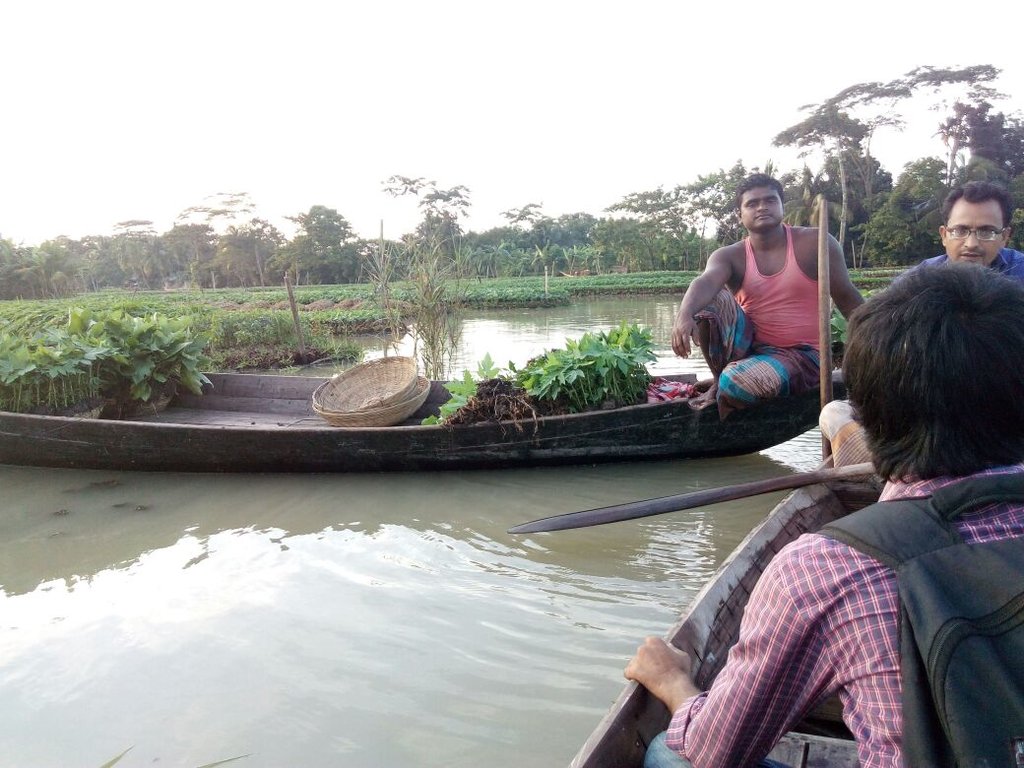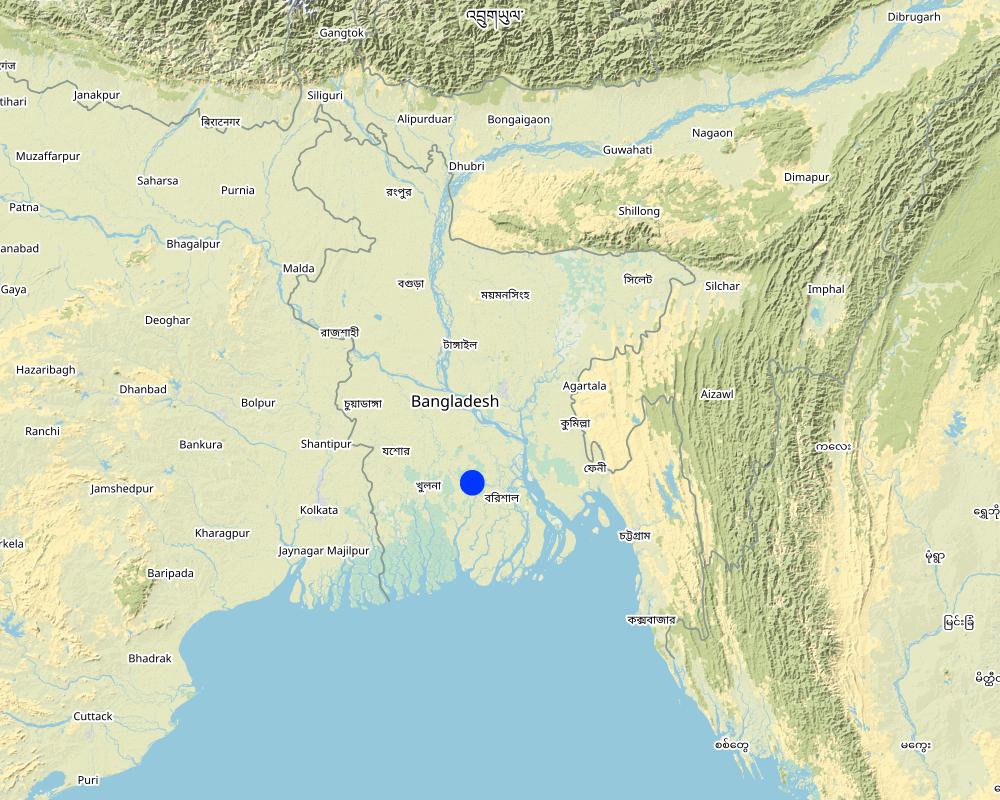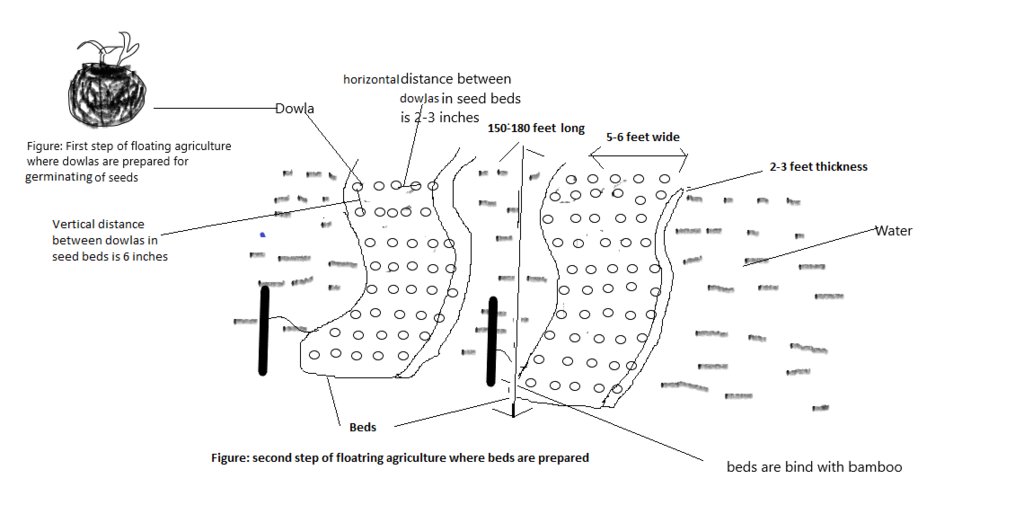FLOATING AGRICULTURE IN WATERLOGGED SOIL [ប្រទេសបង់ក្លាដែស]
- ការបង្កើត៖
- បច្ចុប្បន្នភាព
- អ្នកចងក្រង៖ Naznin Imrana
- អ្នកកែសម្រួល៖ –
- អ្នកត្រួតពិនិត្យច្រើនទៀត៖ Udo Höggel, Rima Mekdaschi Studer
"Dhap poddhoti"
technologies_3619 - ប្រទេសបង់ក្លាដែស
ពិនិត្យមើលគ្រប់ផ្នែក
ពង្រីកមើលទាំងអស់ បង្រួមទាំងអស់1. ព័ត៌មានទូទៅ
1.2 ព័ត៌មានលម្អិតពីបុគ្គលសំខាន់ៗ និងស្ថាប័នដែលចូលរួមក្នុងការវាយតម្លៃ និងចងក្រងឯកសារនៃបច្ចេកទេស
បុគ្គលសំខាន់ម្នាក់ (ច្រើននាក់)
Student in Soil and Environment dept. in University of Barisal:
ឈ្មោះអង្គភាពមួយ (ច្រើន) ដែលបានចងក្រងឯកសារ/ វាយតម្លៃបច្ចេកទេស (បើទាក់ទង)
University (of Barisal) - ប្រទេសបង់ក្លាដែស1.3 លក្ខខណ្ឌទាក់ទងទៅនឹងការប្រើប្រាស់ទិន្នន័យដែលបានចងក្រងតាមរយៈ វ៉ូខេត
តើពេលណាដែលទិន្នន័យបានចងក្រង (នៅទីវាល)?
07/04/2017
អ្នកចងក្រង និង(បុគ្គលសំខាន់ៗ)យល់ព្រមទទួលយកនូវលក្ខខណ្ឌនានាទាក់ទងទៅនឹងការប្រើប្រាស់ទិន្នន័យដែលបានចងក្រងតាមរយៈវ៉ូខេត:
បាទ/ចា៎
1.4 សេចក្តីប្រកាសស្តីពីចីរភាពនៃការពណ៌នាពីបច្ចេកទេស
តើបច្ចេកទេសដែលបានពណ៌នានេះមានបញ្ហាដែលផ្តោតលើការធ្លាក់ចុះគុណភាពដី, បើដូច្នេះវាមិនអាចត្រូវបានប្រកាសថាជាបច្ចេកទេសនៃការគ្រប់គ្រងប្រកបដោយចីរភាពទេ?
ទេ
2. ការពណ៌នាពីបច្ចេកទេស SLM
2.1 ការពណ៌នាដោយសង្ខេបពីបច្ចេកទេស
និយមន័យបច្ចេកទេស:
The aim of this technology is to use the waterlogged soils, which remain under water during 6 to 7 months of a year, for vegetable seedlings. This is done through floating seed beds which are made of water hyacinths.
2.2 ការពណ៌នាលម្អិតពីបច្ចេកទេស
ការពណ៌នា:
Floating agriculture is a special technique to cultivate vegetables and vegetable seedlings such as Pumpkin, Bean, Brinjal, Cucumber, Tomato, Papaya, Green Chili etc. on waterlogged soils. This is done by using floating seed beds, which are made of water hyacinths and other aquatic plants such as Dulalilata (Hygroryza aristata) Tepapana (Pistia stratiotes) and Khudepana (Lemna spirodela).
Paddy cultivation is usually done from October to April. After the paddy harvest, the lands usually remain waterlogged under 7 to 8 feet of water from May to November. With the onset of the rainy season, these regions are covered with water hyacinths and other aquatic plants etc. Normal agricultural production during this period is not possible due to this waterlogged condition and the growing water hyacinths, Dulalilata, Tepapana etc.
However, floating agriculture enables farmers to use this land in the best productive way. Floating agriculture is started by collecting water plants (Hyacinth, Dulalilata, Tepapana) for preparing floating seedbeds using these plants. This is because the vegetable seeds cannot be sown traditionally into the soil. Hence, a nutritious soft ball is prepared by using Tepapana and Khudepana which is called dowla. A small amount of urea fertilizer is put into each dowla. Thereafter, different types of vegetable seeds are sown / placed, in wet condition, into the dowlas. The dowlas so prepared are kept in an open place for drying / sprouting for 3 to 7 days. Thereafter, the dowlas are placed on the floating seedbed, which have been already made, where each Dowla is placed respecting 6 inches of distance in a bed. In such manner and about 2,450 dowlas can be placed in each seedbed. After taking proper care for one month including irrigation every day to prevent root dry up and fertilisation using a little amount urea fertilizer the sprouting seedlings are getting matured and ready for sale.
The establishment costs for a floating seedbed of 150 -180 feet long is between 3000 to 5500 taka. To make such a floating seedbed, a person must work 6 to 8 or 10 hours on a wage of 250 taka per workday. Nearly 25000 thousand women workers of these regions are directly or indirectly involved in this production. Each worker earns 200 to 250 taka per day. On an average, women can prepare between 1000 to 2000 dowlas per day. In this work, a female worker gets an average of 150 to 200 taka per day. A farmer earns 6-7 thousand taka through one time use of bed by selling seedlings within 20-22 days. The seedbeds can be used at least 3 times for seedling production in a season (May to November). So, it is possible to earn 18000 -20000 taka per bed in a season.
After that, the floating beds can be used again for growing vegetables, thus they are able to grow about ten thousand metric tons of vegetables annually in these regions that meets the local demand. Some vegetables are also sent to other regions /communities, achieving a very beneficial profit. It is possible to earn about 2-3 thousand taka by selling vegetables. After completing all these seedlings and vegetables growing processes seedbeds can be sold for between 1-2 thousand taka to other farmers. Therefore, it is possible to earn 20000-250000 taka per bed in a season including all other sources of income, which are mentioned above.
Storm and other climatic hazards cannot do much harm to this cultivation method. Besides, it is possible to produce vegetables throughout the year.
Using this technology allows people of waterlogged regions to turn their wheel of fortune by cultivating vegetables/vegetable seedlings, hence being able to overcome poverty up to 70%.
2.3 រូបភាពនៃបច្ចេកទេស
កំណត់សម្គាល់ទូទៅនៃរូបថត/រូភាព:
These picture represent deatils of the technique
2.5 ប្រទេស/តំបន់/ទីតាំងកន្លែង ដែលបច្ចេកទេសត្រូវបានអនុវត្ត និងបានគ្រប់ដណ្តប់ដោយការវាយតម្លៃនេះ
ប្រទេស:
ប្រទេសបង់ក្លាដែស
តំបន់/រដ្ឋ/ខេត្ត:
Nazirpur Upazila (upazila means sub unit of a district), Pirojpur District
បញ្ជាក់បន្ថែមពីលក្ខណៈនៃទីតាំង:
Gaokhali,Mugarjhor,Bisharkandi,Bildumoria etc
Map
×2.6 កាលបរិច្ឆេទនៃការអនុវត្ត
ប្រសិនបើមិនច្បាស់ឆ្នាំ សូមបញ្ជាក់កាលបរិច្ឆេទដែលប្រហាក់ប្រហែល:
- ច្រើនជាង 50 ឆ្នាំមុន (ប្រពៃណី)
2.7 ការណែនាំពីបច្ចេកទេស
សូមបញ្ជាក់តើបច្ចេកទេសត្រូវបានណែនាំឱ្យអនុវត្តដោយរបៀបណា:
- តាមរយៈការបង្កើតថ្មីរបស់អ្នកប្រើប្រាស់ដី
3. ចំណាត់ថ្នាក់នៃបច្ចេកទេស SLM
3.1 គោលបំណងចម្បង (១ ឬច្រើន) នៃបច្ចេកទេសនេះ
- ធ្វើឱ្យប្រសើរឡើងនូវផលិតកម្ម
- បង្កើតផលប្រយោជន៍សេដ្ឋកិច្ច
- បង្កើតផលប្រយោជន៍សង្គម
3.2 ប្រភេទដីប្រើប្រាស់មួយប្រភេទ (ច្រើនប្រភេទ) ដែលបានអនុវត្តបច្ចេកទេស

ផ្លូវទឹក ផ្ទៃទឹក ដីសើម
- waterlogged area
3.3 ព័ត៌មានបន្ថែមអំពីអ្នកប្រើប្រាស់ដី
ការផ្គត់ផ្គង់ទឹកនៅកន្លែងអនុវត្តបច្ចេកទេស:
- ទឹកភ្លៀង
ចំនួនសារដែលដាំដំណាំក្នុងមួយឆ្នាំ:
- 1
3.4 ក្រុម SLM ដែលបច្ចេកទេសស្ថិតនៅក្នុង
- ការគ្រប់គ្រង/ ការការពារតំបន់ដីសើម
3.5 ការសាយភាយនៃបច្ចេកទេស
បញ្ជាក់ពីការសាយភាយនៃបច្ចេកទេស:
- អនុវត្តនៅកន្លែងជាក់លាក់មួយ/ ប្រមូលផ្តុំនៅតំបន់តូចៗ
មតិយោបល់:
This technology is applicable for some specific regions (Banaripara, Agailjhara Ujirpur, Pirojpur’s Nazirpur and Swarupkathi Upazila), as they remain waterlogged from May to October.
3.6 វិធានការ SLM ដែលបញ្ចូលនូវបច្ចេកទេស

វិធានការក្សេត្រសាស្ត្រ
- A1: ដំណាំ/គម្របដី

វិធានការរចនាស័ម្ពន្ធ
- S11: ផ្សេងៗ

វិធានការគ្រប់គ្រង
- M1: ការផ្លាស់ប្តូរប្រភេទដីប្រើប្រាស់
3.8 ការពារ កាត់បន្ថយ ឬស្តារឡើងវិញនៃការធ្លាក់ចុះគុណភាពដី
បញ្ជាក់ពីគោលដៅរបស់បច្ចេកទេស ដែលផ្តោតទៅការធ្លាក់ចុះគុណភាពដី:
- ដែលមិនអាចអនុវត្តបាន
4. បច្ចេកទេសជាក់លាក់ សកម្មភាពអនុវត្ត ធាតុចូល និងថ្លៃដើម
4.1 គំនូសបច្ចេកទេសនៃបច្ចេកទេសនេះ
4.2 លក្ខណៈពិសេសនៃបច្ចេកទេស/ ពណ៌នាពីគំនូរបច្ចេកទេស
Seed bed and construction material:
-Dimensions: 150 to 180 feet long, 5-6 feet width and thickness 2 to 3 ft.
-Horizontal spacing between structures or plants / vegetative measures (dowlas) : 2-3 inches
-Vertical intervals between structures or vegetative measures: 6 inches
The seedbed consists of floating carpets of water hyacinth, dulalilata (Hygroryza aristata), tepapana (Pistia stratiotes) and other aquatic plants.
Dowla and construction material:
Dowlas are constructed by using tepapana (Pistia stratiotes) and khudepana (Lemna spirodela) water plants that are rolled into a soft ball. The density of dowlas within a seedbed is 2450 seedlings.
4.3 ព័ត៌មានទូទៅដែលពាក់ព័ន្ធនឹងការគណនាធាតុចូល និងថ្លៃដើម
កំណត់របៀបនៃការគណនាថ្លៃដើម និងធាតុចូល:
- ក្នុងតំបន់អនុវត្តបច្ចេកទេស
កំណត់ទំហំ និងឯកត្តាផ្ទៃដី:
approx. 750 sq feet (70 m2)
បើសិនប្រើឯកតាតាមផ្ទៃដីក្នុងមូលដ្ឋាន សូមបញ្ជាក់ពីខ្ជាតប្តូរទៅជាហិកតា:
1 ha = 107639 sq feet
ផ្សេងៗ/ រូបិយប័ណ្ណជាតិ (បញ្ជាក់):
Taka
កំណត់អត្រាប្តូរប្រាក់ពីដុល្លាទៅរូបិយប័ណ្ណតំបន់ (បើទាក់ទង)៖ 1 ដុល្លារ =:
82,7344
កំណត់ថ្លៃឈ្នួលជាមធ្យមនៃការជួលកម្លាំងពលកម្មក្នុងមួយថ្ងៃ:
250 taka
4.4 សកម្មភាពបង្កើត
| សកម្មភាព | ប្រភេទវិធានការ | ពេលវេលា | |
|---|---|---|---|
| 1. | Dowla | ក្សេត្រសាស្ត្រ | May to November |
| 2. | Seed bed | ក្សេត្រសាស្ត្រ | May to November |
| 3. | Planting of dowlas into seedbeds | ក្សេត្រសាស្ត្រ | May to November |
4.5 ថ្លៃដើម និងធាតុចូលដែលត្រូវការសម្រាប់ការបង្កើតបច្ចេកទេស
| បញ្ជាក់ពីធាតុចូល | ឯកតា | បរិមាណ | ថ្លៃដើមក្នុងមួយឯកតា | ថ្លៃធាតុចូលសរុប | % នៃថ្លៃដើមដែលចំណាយដោយអ្នកប្រើប្រាស់ដី | |
|---|---|---|---|---|---|---|
| កម្លាំងពលកម្ម | Seedbed of 150 to 180 feet long | labour/per bed | 3,0 | 250,0 | 750,0 | 100,0 |
| កម្លាំងពលកម្ម | Dowla | labour/2450 dowla | 2,0 | 200,0 | 400,0 | 100,0 |
| សម្ភារៈដាំដុះ | Seed (e.g. pumpkin) | kg | 2,0 | 400,0 | 800,0 | 100,0 |
| ជី និងសារធាតុពុល | Urea | kg | 1,0 | 16,0 | 16,0 | 100,0 |
| សម្ភារៈសាងសង់ | Water hyacinth | ton | 5,0 | 200,0 | 1000,0 | 100,0 |
| សម្ភារៈសាងសង់ | Dulalilata (Hygroryza aristata) | ton | 2,0 | 500,0 | 1000,0 | 100,0 |
| សម្ភារៈសាងសង់ | Tepapana (Pistia stratiotes) | ton | 3,0 | 333,0 | 999,0 | 100,0 |
| សម្ភារៈសាងសង់ | Khudepana (Lemna spirodela) | ton | 0,5 | 1000,0 | 500,0 | 100,0 |
| ថ្លៃដើមសរុបក្នុងការបង្កើតបច្ចេកទេស | 5465,0 | |||||
4.6 សកម្មភាពថែទាំ
| សកម្មភាព | ប្រភេទវិធានការ | ពេលវេលា/ ភាពញឹកញាប់ | |
|---|---|---|---|
| 1. | Watch and ward | ការគ្រប់គ្រង | May to November |
4.7 កំណត់ថ្លៃដើមសម្រាប់ការថែទាំ/ សកម្មភាពរបស់បច្ចេកទេស (ក្នុងរយៈពេលមួយឆ្នាំ)
| បញ្ជាក់ពីធាតុចូល | ឯកតា | បរិមាណ | ថ្លៃដើមក្នុងមួយឯកតា | ថ្លៃធាតុចូលសរុប | % នៃថ្លៃដើមដែលចំណាយដោយអ្នកប្រើប្រាស់ដី | |
|---|---|---|---|---|---|---|
| កម្លាំងពលកម្ម | Watch and ward | per bed | 2,0 | 200,0 | 400,0 | 100,0 |
| ថ្លៃដើមសរុបសម្រាប់ការថែទាំដំណាំតាមបច្ចេកទេស | 400,0 | |||||
4.8 កត្តាសំខាន់បំផុតដែលមានឥទ្ធិពលដល់ការចំណាយ
ពណ៌នាពីកត្តាប៉ះពាល់ចម្បងៗទៅលើថ្លៃដើម:
Labor cost, price of seed and price of urea fertilizer, Dulalilata (Hygroryza aristata), Tepapana (Pistia stratiotes) and Khudepana (Lemna spirodela)
5. លក្ខណៈបរិស្ថានធម្មជាតិ និងមនុស្ស
5.1 អាកាសធាតុ
បរិមាណទឹកភ្លៀងប្រចាំឆ្នាំ
- < 250 មម
- 251-500 មម
- 501-750 មម
- 751-1,000 មម
- 1,001-1,500 មម
- 1,501-2,000 មម
- 2,001-3,000 មម
- 3,001-4,000 មម
- > 4,000 មម
តំបន់កសិអាកាសធាតុ
- សើម
5.2 សណ្ឋានដី
ជម្រាលជាមធ្យម:
- រាបស្មើ (0-2%)
- ជម្រាលតិចតួច (3-5%)
- មធ្យម (6-10%)
- ជម្រាលខ្ពស់បន្តិច (11-15%)
- ទីទួល (16-30%)
- ទីទួលចោត (31-60%)
- ទីទួលចោតខ្លាំង (>60%)
ទម្រង់ដី:
- ខ្ពង់រាប
- កំពូលភ្នំ
- ជម្រាលភ្នំ
- ជម្រាលទួល
- ជម្រាលជើងភ្នំ
- បាតជ្រលងភ្នំ
តំបន់តាមរយៈកម្ពស់ :
- 0-100 ម
- 101-500 ម
- 501-1,000 ម
- 1,001-1,500 ម
- 1,501-2,000 ម
- 2,001-2,500 ម
- 2,501-3,000 ម
- 3,001-4,000 ម
- > 4,000 ម
បញ្ជាក់ថាតើបច្ចេកទេសនេះត្រូវបានអនុវត្តន៍នៅក្នុង:
- មិនពាក់ព័ន្ធទាំងអស់
5.3 ដី
ជម្រៅដីជាមធ្យម:
- រាក់ខ្លាំង (0-20 សម)
- រាក់ (21-50 សម)
- មធ្យម (51-80 សម)
- ជ្រៅ (81-120 សម)
- ជ្រៅខ្លាំង (> 120 សម)
វាយនភាពដី (ស្រទាប់លើ):
- មធ្យម (ល្បាយ, ល្បាប់)
- ម៉ត់/ ធ្ងន់ (ឥដ្ឋ)
សារធាតុសរីរាង្គនៅស្រទាប់ដីខាងលើ:
- ទាប (<1%)
5.4 ទឹកដែលអាចទាញមកប្រើប្រាស់បាន និងគុណភាពទឹក
នីវ៉ូទឹកក្រោមដី:
< 5 ម
គុណភាពទឹក (មិនបានធ្វើប្រត្តិកម្ម):
ទឹកសម្រាប់តែការធ្វើកសិកម្ម (ស្រោចស្រព)
តើមានបញ្ហាភាពទឹកប្រៃហូរចូលមកដែរឬទេ?
ទេ
តើទឹកជំនន់កំពុងកើតមាននៅតំបន់នេះដែររឺទេ?
ទេ
មតិយោបល់ និងលក្ខណៈពិសេសផ្សេងៗទៀតលើគុណភាព និងបរិមាណទឹក :
Waterlogged condition promote the excessive growth of water hyacinths thus causing water pollution
5.5 ជីវៈចម្រុះ
ភាពសម្បូរបែបនៃប្រភេទ:
- កម្រិតមធ្យម
ភាពសម្បូរបែបនៃទីជម្រក:
- កម្រិតមធ្យម
5.6 លក្ខណៈនៃអ្នកប្រើប្រាស់ដីដែលអនុវត្តបច្ចេកទេស
ទីផ្សារនៃប្រព័ន្ធផលិតកម្ម:
- ពាណិជ្ជកម្ម/ ទីផ្សារ
ចំណូលក្រៅកសិកម្ម:
- 10-50% នៃចំណូល
កម្រិតជីវភាព:
- មិនល្អខ្លាំង
- មិនល្អ
ឯកជន ឬក្រុម:
- ធ្វើខ្លួនឯង/ គ្រួសារ
កម្រិតប្រើប្រាស់គ្រឿងយន្ត:
- ប្រើកម្លាំងពលកម្ម
យេនឌ័រ:
- ស្ត្រី
- បុរស
5.7 ទំហំផ្ទៃដីជាមធ្យមនៃដីផ្ទាល់ខ្លួន ឬជួលគេដែលបានអនុវត្តបច្ចេកទេស
- < 0.5 ហិកតា
- 0.5-1 ហិកតា
- 1-2 ហិកតា
- 2-5 ហិកតា
- 5-15 ហិកតា
- 15-50 ហិកតា
- 50-100 ហិកតា
- 100-500 ហិកតា
- 500-1,000 ហិកតា
- 1,000-10,000 ហិកតា
- > 10,000 ហិកតា
តើផ្ទៃដីនេះចាត់ទុកជាទំហំកម្រិតណាដែរ ខ្នាតតូច មធ្យម ឬខ្នាតធំ (ធៀបនឹងបរិបទតំបន់)?
- ខ្នាតតូច
5.8 ភាពជាម្ចាស់ដី កម្មសិទ្ធប្រើប្រាស់ដី និងកម្មសិទ្ធប្រើប្រាស់ទឹក
ភាពជាម្ចាស់ដី:
- ឯកជន មានកម្មសិទ្ធ
កម្មសិទ្ធិប្រើប្រាស់ដី:
- កិច្ចសន្យាជួល
- ឯកជន
កម្មសិទ្ធប្រើប្រាស់ទឹក:
- កិច្ចសន្យាជួល
5.9 ការប្រើប្រាស់សេវាកម្ម និងហេដ្ឋារចនាសម្ព័ន្ធ
សុខភាព:
- មិនល្អ
- មធ្យម
- ល្អ
ការអប់រំ:
- មិនល្អ
- មធ្យម
- ល្អ
ជំនួយបច្ចេកទេស:
- មិនល្អ
- មធ្យម
- ល្អ
ការងារ (ឧ. ការងារក្រៅកសិដ្ឋាន):
- មិនល្អ
- មធ្យម
- ល្អ
ទីផ្សារ:
- មិនល្អ
- មធ្យម
- ល្អ
ថាមពល:
- មិនល្អ
- មធ្យម
- ល្អ
ផ្លូវ និងការដឹកជញ្ជូន:
- មិនល្អ
- មធ្យម
- ល្អ
ទឹកផឹក និងអនាម័យ:
- មិនល្អ
- មធ្យម
- ល្អ
សេវាកម្មហិរញ្ញវត្ថុ:
- មិនល្អ
- មធ្យម
- ល្អ
6. ផលប៉ះពាល់ និងការសន្និដ្ឋាន
6.1 ផលប៉ះពាល់ក្នុងបរិវេណអនុវត្តបច្ចេកទេសដែលកើតមាន
ផលប៉ះពាល់លើសេដ្ឋកិច្ចសង្គម
ផលិតផល
ផលិតកម្មដំណាំ
មតិយោបល់/ ការបញ្ជាក់:
Best use of water hyacinths and barren waterlogged soil
ចំណូល និងថ្លៃដើម
ការចំណាយលើធាតុចូលកសិកម្ម
មតិយោបល់/ ការបញ្ជាក់:
No heavy machinery or costly fertilizers is used in this technology. In this technology, farmers cultivate crops in a simple way using water hyacinths which is a great source of organic fertilizer.
ផលប៉ះពាល់ទៅលើវប្បធម៌សង្គម
សន្តិសុខស្បៀង/ ភាពគ្រប់គ្រាន់ខ្លួនឯង
ឱកាសវប្បធម៍
មតិយោបល់/ ការបញ្ជាក់:
Spiritual, aesthetics and other cultural opportunities are improved by the cash from vegetables.
ឱកាសនៃការបង្កើតថ្មី
មតិយោបល់/ ការបញ្ជាក់:
Tourist people are attracted by the green beauty of waterlogged areas when the fields are full of different crops. Tourists can also make a boat trip during raniy season when the areas expand into a board shallow sheets of water.
ស្ថាប័នសហគមន៍
មតិយោបល់/ ការបញ្ជាក់:
Socioeconomic conditions of people in waterlogged areas where this technology is being used for crop production, have improved.
ស្ថាប័នជាតិ
ផលប៉ះពាល់ទៅលើអេកូឡូស៊ី
វដ្តទឹក/លំហូរ
ប្រព័ន្ធបង្ហូរទឹក
មតិយោបល់/ ការបញ្ជាក់:
As at least 5 to 6 months the soil remains in waterlogged condition so there is very less possibility to excess water drainage
នីវ៉ូទឹកក្រោមដី/ ដង្ហើមទឹក
មតិយោបល់/ ការបញ្ជាក់:
This land acts as recharge areas holding and storing the surface water and allowing it to percolate down through the soil and rock to the ground water
ដី
សំណើមដី
មតិយោបល់/ ការបញ្ជាក់:
In waterlogged soil the soil pores are filled with water hence, it increases soil moisture
ការកាត់បន្ថយហានិភ័យនៃគ្រោះមហន្តរាយ និងគ្រោះអាកាសធាតុ
ផលប៉ះពាល់នៃទឹកជំនន់
មតិយោបល់/ ការបញ្ជាក់:
Waterlogged areas collect, store and hold flood waters and ultimately control and reduce flood damage
6.3 ភាពប្រឈម និងភាពរួសនៃបច្ចេកទេសទៅនឹងការប្រែប្រួលអាកាសធាតុ និងគ្រោះអាកាសធាតុ/ គ្រោះមហន្តរាយ (ដែលដឹងដោយអ្នកប្រើប្រាស់ដី)
ការប្រែប្រួលអាកាសធាតុ
ការប្រែប្រួលអាកាសធាតុ
| រដូវកាល | ប្រភេទនៃការប្រែប្រួលអាកាសធាតុ/ព្រឹត្តិការណ៍ | លក្ខណៈឆ្លើយតបនៃបច្ចេកទេសទៅនឹងការប្រែប្រួលអាកាសធាតុ | |
|---|---|---|---|
| សីតុណ្ហភាពប្រចាំឆ្នាំ | កើនឡើង | មិនល្អ |
គ្រោះអាកាសធាតុ (មហន្តរាយ)
គ្រោះមហន្តរាយធម្មជាតិ
| លក្ខណៈឆ្លើយតបនៃបច្ចេកទេសទៅនឹងការប្រែប្រួលអាកាសធាតុ | |
|---|---|
| ព្យុះភ្លៀងតាមតំបន់ | មិនល្អ |
| ព្យុះកំបុតត្បូងតាមតំបន់ | មិនល្អ |
6.4 ការវិភាគថ្លៃដើម និងអត្ថប្រយោជន៍
តើផលចំណេញ និងថ្លៃដើមត្រូវបានប្រៀបធៀបគ្នាយ៉ាងដូចម្តេច (ទស្សនៈរបស់អ្នកប្រើប្រាស់ដី)?
រយៈពេលខ្លី:
វិជ្ជមានខ្លាំង
រយៈពេលវែង:
វិជ្ជមាន
តើផលចំណេញ និងការថែទាំ/ ជួសជុលត្រូវបានប្រៀបធៀបគ្នាយ៉ាងដូចម្តេច (ទស្សនៈរបស់អ្នកប្រើប្រាស់ដី)?
រយៈពេលខ្លី:
វិជ្ជមានខ្លាំង
រយៈពេលវែង:
វិជ្ជមាន
6.5 ការទទួលយកបច្ចេកទេស
- ច្រើនជាង 50%
ក្នុងចំណោមគ្រួសារទាំងអស់ដែលអនុវត្តបច្ចេកទេស តើមានប៉ុន្មានគ្រួសារដែលចង់ធ្វើដោយខ្លួនឯង ដោយមិនទទួលបានសម្ភារៈលើកទឹកចិត្ត/ប្រាក់ឧបត្ថម្ភ?:
- 90-100%
6.6 ការបន្សុំា
តើថ្មីៗនេះ បច្ចេកទេសនេះត្រូវបានកែតម្រូវដើម្បីបន្ស៊ាំទៅនឹងស្ថានភាពប្រែប្រួលដែរឬទេ?
ទេ
6.7 ភាពខ្លាំង/ គុណសម្បត្តិ/ ឱកាសនៃបច្ចេកទេស
| ភាពខ្លាំង/ គុណសម្បត្តិ/ ឱកាសនៅកន្លែងរបស់អ្នកប្រើប្រាស់ដី |
|---|
| Early production of seedling of vegetables |
| Increase vegetables supply in waterlogged area |
| Highly resistant to pest |
| Crops require shorter time to mature when cultivated in floating platforms |
| Require very less amount of fertilizer and pesticide |
| ភាពខ្លាំង/ គុណសម្បត្តិ/ ឱកាស ទស្សនៈរបស់បុគ្គលសំខាន់ៗ |
|---|
| Prime nutrient elements such as nitrogen, potassium and phosphorus are available in water hyacinth and other aquatic plant so no need to supplement for plant growth |
| It is the best utilization of water-logged land |
| After harvesting of vegetables the seedbeds gradually start to decompose which, are an immense source of organic matter. Thus the soil quality is improved. |
| It improves the socio-economic conditions of the farmers of the water-logged area |
| Eco friendly |
| It is the best use of water hyacinths which otherwise cause water pollution and destroy the aquatic ecosystem |
6.8 ភាពខ្សោយ/ គុណវិបត្តិ/ ហានិភ័យនៃបច្ចេកទេស និងវិធីសាស្ត្រដោះស្រាយ
| ភាពខ្សោយ/ គុណវិបត្តិ/ ហានិភ័យ ទស្សនៈរបស់អ្នកប្រើប្រាស់ដី | តើបច្ចេកទេសទាំងនោះបានដោះស្រាយបញ្ហាដូចម្តេច? |
|---|---|
| Shortage of financial supports | Need more financial help to execute this technique from different organizations |
| Farmers get difficulties to get loan | Ensure easy loan facilities with less interest |
| Sometimes seed and fertilizer price goes so high that farmers couldn't afford buying | So, in this perspective they need free marketing of seed and fertilizer |
| Lack of quality seeds | Ensure quality seeds by establishing Bangladesh Agricultural DC seed sell center in the area |
| Improved Governmental and Non governmental agricultural organizations involvement | Governmental and Non governmental agricultural organization should come forward in this perspective for providing additional help to the farmers |
| ភាពខ្សោយ/ គុណវិបត្តិ/ ហានិភ័យ ទស្សនៈរបស់អ្នកចងក្រងឬបុគ្គលសំខាន់ៗ | តើបច្ចេកទេសទាំងនោះបានដោះស្រាយបញ្ហាដូចម្តេច? |
|---|---|
| Lack of expert persons | Need more expert persons to spread the skill about this technique among the farmers |
| Lack of knowledge in use of water hyacinth | Spread the knowledge about beneficial used of water hyacinth |
| Fraud market | Minimize the violence of intermediate fraud market as for this farmers are deprived of their attainable price |
7. ឯកសារយោង និងវេបសាយ
7.1 វិធីសាស្ត្រ/ ប្រភពនៃព័ត៌មាន
- តាមការចុះទីវាល ការស្រាវជ្រាវនៅទីវាល
3
- ការសម្ភាសន៍ជាមួយអ្នកប្រើប្រាស់ដី
3
7.2 ឯកសារយោងដែលបានចេញផ្សាយ
ចំណងជើង អ្នកនិពន្ធ ឆ្នាំ ISBN:
Floating Garden Practices
មានប្រភពមកពីណា? ថ្លៃដើមប៉ុន្មាន?
www.fao.org/giahs/giahsaroundtheworld/designated-sites/asia-and-the-pacific/floating-garden-agricultural-practices/detailed-information/en/
ចំណងជើង អ្នកនិពន្ធ ឆ្នាំ ISBN:
Floating Bed Cultivation and Gardening in Bangladesh
មានប្រភពមកពីណា? ថ្លៃដើមប៉ុន្មាន?
http://www.ideassonline.org/public/pdf/FloatingGardensBangladesh-ENG.pdf
ចំណងជើង អ្នកនិពន្ធ ឆ្នាំ ISBN:
Floating vegetable farming boon for marginal farmers; S Dilip Roy; Daily Star; 2012
មានប្រភពមកពីណា? ថ្លៃដើមប៉ុន្មាន?
https://www.thedailystar.net/news-detail-217543
ចំណងជើង អ្នកនិពន្ធ ឆ្នាំ ISBN:
Floating agricultural systems
មានប្រភពមកពីណា? ថ្លៃដើមប៉ុន្មាន?
https://www.ctc-n.org/sites/www.ctc-n.org/files/resources/floating_agricultural_systems.pdf
ចំណងជើង អ្នកនិពន្ធ ឆ្នាំ ISBN:
Floating Garden Agricultural Practices
មានប្រភពមកពីណា? ថ្លៃដើមប៉ុន្មាន?
http://www.fao.org/giahs/giahsaroundtheworld/designated-sites/asia-and-the-pacific/floating-garden-agricultural-practices/detailed-information/en/
ការតភ្ជាប់ និងម៉ូឌុល
ពង្រីកមើលទាំងអស់ បង្រួមទាំងអស់ការតភ្ជាប់
គ្មានការតភ្ជាប់
ម៉ូឌុល
គ្មានម៉ូឌុល


